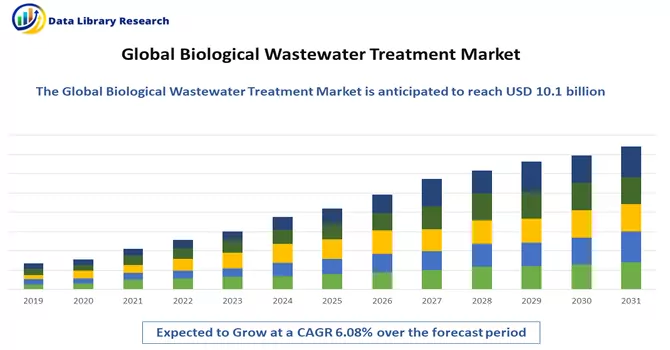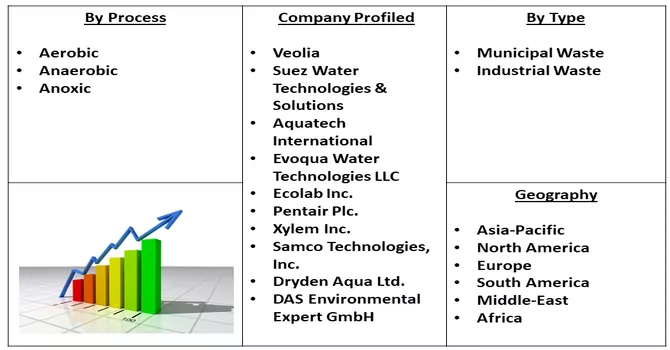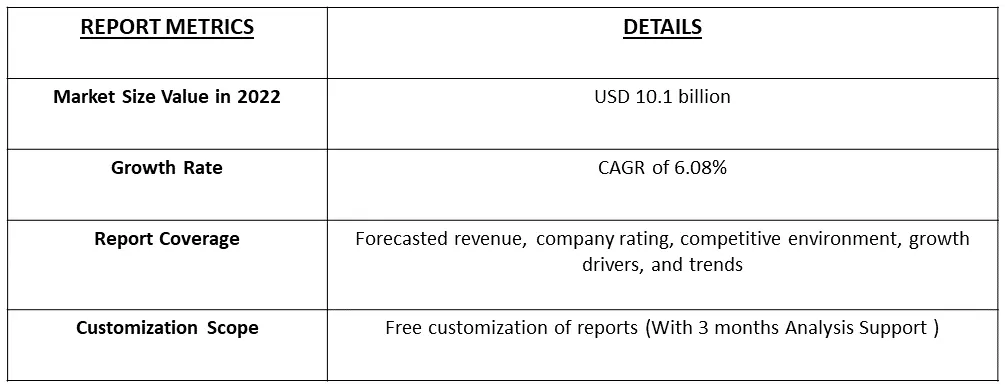The Biological Wastewater Treatment Market is currently valued at USD 10.1 billion in the year 2022 and is expected to register a CAGR of 6.08% over the forecast period, 2023-2030.

Get Complete Analysis Of The Report - Download Free Sample PDF
Biological wastewater treatment is a modern technique in which wastewater is treated with microorganisms instead of chemicals. In this way, we try to prevent the adverse effects caused by chemical treatment of wastewater such as chemical accumulation in water bodies or algal blooming.
The demand for wastewater treatment facilities is expected to increase during the projection period due to declining freshwater supplies and growing water shortages. Due to the scarcity of freshwater resources and the increased demand for water in diverse desert locations, more wastewater treatment facilities are being constructed globally. The rise in industrialization and increased demand for water are expected to be the major driving factors in the market's growth.
The market for biological wastewater treatment is growing as a result of several factors, including the rapid urbanization and growth of the population, the regulations governing water treatment that are increasing demand for new water resources due to the rising importance of public health and water quality, and the rising incidence of waterborne diseases. Additionally, in the coming years, there will likely be considerable growth prospects for companies that manufacture water and wastewater treatment systems due to the increase in the need for energy-efficient and sophisticated water treatment technology.
The growth of this market, however, is anticipated to be significantly constrained by the high costs of installation, upkeep, and operation. Furthermore, one of the most significant barriers to the expansion of the water and wastewater treatment business is the deterioration and corrosion of the current water infrastructure.
Segmentation:
The Biological Wastewater Treatment Market is Segmented by Biological Wastewater Treatment Market
By Process
By Type
Geography
The report offers market size and values in (USD million) during the forecasted years for the above segments.

For Detailed Market Segmentation - Download Free Sample PDF
Drivers:
Increasing Industrialization and Rising Volume of Wastewater to Fuel the Market Growth
The major drivers for the growth of the market for biological wastewater treatment are anticipated to be the increase in industrialization and government water conservation programs. To operate daily, many businesses need enormous amounts of water. Water shortages for the population may result from the use of fresh water. Industries can reuse water for operational purposes repeatedly with the aid of biological wastewater treatment. Due to the causes mentioned above, the industrialization rate is rising, which is fueling the market for biological wastewater treatment. The need for water also rises as the population grows. One of the projected driving forces for the market is the government's multiple initiatives for water purification as a result of the growing population.
Increasing Number of Government Activities Aimed at Increasing Consumer Awareness to Drive Excellent Opportunities
With the rising awareness about using and drinking sanitary and safe water amid this chaos, various governments and non-profit organizations around the world are launching numerous programs. These programs are raising the need for water treatment services, which is driving up the growth of biological wastewater treatment throughout the projection period. Additionally increased industrialization and government water conservation policies. Many industries require massive amounts of water daily. The use of freshwater creates water scarcity for the population. Industries can reuse water for operational processes with the help of biological wastewater treatment, which significantly contributes to the global biological wastewater treatment market growth.
In December 2022, The Delhi government has planned to set up a water recycling unit of two million gallons per day (MGD) capacity in Bawana, a census town in northwest Delhi, according to an official statement made earlier this week. This will help provide round-the-clock water supply to the residents of the city, it added. Thus, such developments are expected to drive the growth of the studied market.
Restraints:
The market's expected expansion would be hampered by the high costs associated with properly disposing of tainted water
The market's growth is expected to be hampered by the high cost of wastewater treatment. The main market barrier to entry is the high operational expenses, sludge transportation costs, and other potential expenditures associated with water filtration. Additionally, biological wastewater treatment offers several options to address the issues, but it also needs space to set up the equipment and store the necessary water in gallons. The price and available area required for the setup are likely to limit market growth throughout the anticipated term.
The COVID-19 impact on the biological wastewater treatment market epidemic has affected the world economy by stopping the activities of various sectors. The World Health Organization determined that washing hands with soap and water is a basic process for combating coronaviruses. However, research has shown that about 3 billion people do not have access to safe drinking water. As a result, people are particularly vulnerable to the potentially lethal infection. As a result, governments are focusing more on the provision of safe drinking water. This has increased the global need for wastewater treatment. As a result, demand for biological wastewater treatment is expected to increase throughout the forecast period. Furthermore, the developments related to wastewater treatment during COVID-19 are expected to contribute to the growth of the studied market. For instance, in September 2020, the Suez Group took a new initiative to produce biological wastewater treatment market growth. Suez Group introduced SARS-CoV-2 presence sensors that can identify the British variation among other SARS-CoV-2 infections in wastewater networks. Approximately 13 million people in Spain today use this system, which was created by the Suez Group, in about 100 local communities. Thus, COVID-19 increased the demand for the wastewater treatment.
The armed conflict between Ukraine and Russia that began in late February 2022 has far-reaching environmental consequences, especially regarding water resources and management. The impacts of the armed conflict on freshwater resources and water infrastructure in Ukraine highlight diverse and long-lasting consequences for local populations and thus it was reported that there was a growing need for wastewater treatment in order the safeguard the water resources thus increasing the demand for waste water treatment.
Segmental Analysis:
The Process Aerobic Segment is Expected to Witness Significant Growth Over the Forecast Period
Aerobic treatment of wastewater is a biological process that uses oxygen to break down organic contaminants and other pollutants like nitrogen and phosphorous. Oxygen is continuously mixed into the wastewater or sewage by a mechanical aeration device, such as an air blower or compressor. Furthermore, the recent developments are expected to drive the growth of the segment. For instance, in August 2023, BCL6000™ is a blend of aerobic and facultative anaerobic microorganisms in liquid form. It is effective in degrading many types of waste and is especially convenient for ongoing maintenance because it can be applied by automatic pumping. BCL6000 improves treatment plant performance while keeping odors, BOD, and foam in check. The main benefits can be summarized as follows: better effluent quality, lower BOD, fewer unpleasant odors, reduced plant upsets from shocks, and improved sludge settling.
The Industrial Segment is Expected to Witness High Growth Over the Forecast Period.
Industrial wastewater treatment describes the processes used for treating wastewater that is produced by industries as an undesirable by-product. After treatment, the treated industrial wastewater (or effluent) may be reused or released to a sanitary sewer or to surface water in the environment. Some industrial facilities generate wastewater that can be treated in sewage treatment plants. Most industrial processes, such as petroleum refineries, and chemical and petrochemical plants have their specialized facilities to treat their wastewater so that the pollutant concentrations in the treated wastewater comply with the regulations regarding disposal of wastewater into sewers or rivers, lakes, or oceans.
The North American region is Expected to Witness High Growth Over the Forecast Period
The North American biological wastewater treatment market analysis is expected to account for the highest market share due to the high demand for biological wastewater treatment driven by rapid urbanization, the expanding need for sophisticated household water treatment, developments in membrane technology, accelerated environmental deterioration, the region's restricted water resource availability, and the rise in number of public sector entities investing in water infrastructure. According to the United Nations Educational, Scientific, and Cultural Organization (UNESCO), the majority of urban and industrial wastewater is generated in Europe (71%), whereas just 20% is treated in North America. In North America, an estimated 51% of municipal and industrial wastewater was treated. In humid regions of high-income nations, wastewater treatment, usage, and disposal are governed by strict effluent discharge rules and public awareness of environmental quality (especially in North America).

Get Complete Analysis Of The Report - Download Free Sample PDF
Competitive Landscape:
The Wastewater Treatment Market is highly competitive due to the presence of many major players working globally and regionally in this market segment. Some of the major players working in this market segment are:
Recent Developments:
1) In July 2023: Bionetix International is excited to release BCP-EU-FB, a microbial wastewater treatment previously available only to a limited European audience. This synergistic blend of microorganisms is a powerhouse of sludge reducing wastewater treatment efficiency with multiple side benefits for waste treatment around the globe.
2) In April 2023: Peab has been commissioned to continue to extend Trollhättan’s wastewater treatment plant. The project includes casting new basins in blasted vaults and installing process equipment that will clean the wastewater. The customer is Trollhättan Energi AB and the contract is worth SEK 355 million. Trollhättan Energi AB is running the project Bio3 to increase the capacity of the existing wastewater treatment plant and fulfill future requirements for water released into Göta River. Bio3 is an extension that will complement the existing wastewater treatment plant and comprises biological, mechanical, and chemical treatment.
Q1. What is the Growth Rate of the Biological Wastewater Treatment Market?
Biological Wastewater Treatment Market is expected to register a CAGR of 6.08% over the forecast period.
Q2. What is the current Biological Wastewater Treatment Market size?
The Biological Wastewater Treatment Market is currently valued at USD 10.1 billion.
Q3. Which Region is expected to hold the highest Market share?
The North American region is expected to hold the highest Market share.
Q4. What segments are covered in the Biological Wastewater Treatment Market Report?
By Process, By Type & Geography these segments are covered in the Biological Wastewater Treatment Market Report.
Data Library Research are conducted by industry experts who offer insight on industry structure, market segmentations technology assessment and competitive landscape (CL), and penetration, as well as on emerging trends. Their analysis is based on primary interviews (~ 80%) and secondary research (~ 20%) as well as years of professional expertise in their respective industries. Adding to this, by analysing historical trends and current market positions, our analysts predict where the market will be headed for the next five years. Furthermore, the varying trends of segment & categories geographically presented are also studied and the estimated based on the primary & secondary research.
In this particular report from the supply side Data Library Research has conducted primary surveys (interviews) with the key level executives (VP, CEO’s, Marketing Director, Business Development Manager and SOFT) of the companies that active & prominent as well as the midsized organization
FIGURE 1: DLR RESEARH PROCESS

Extensive primary research was conducted to gain a deeper insight of the market and industry performance. The analysis is based on both primary and secondary research as well as years of professional expertise in the respective industries.
In addition to analysing current and historical trends, our analysts predict where the market is headed over the next five years.
It varies by segment for these categories geographically presented in the list of market tables. Speaking about this particular report we have conducted primary surveys (interviews) with the key level executives (VP, CEO’s, Marketing Director, Business Development Manager and many more) of the major players active in the market.
Secondary ResearchSecondary research was mainly used to collect and identify information useful for the extensive, technical, market-oriented, and Friend’s study of the Global Extra Neutral Alcohol. It was also used to obtain key information about major players, market classification and segmentation according to the industry trends, geographical markets, and developments related to the market and technology perspectives. For this study, analysts have gathered information from various credible sources, such as annual reports, sec filings, journals, white papers, SOFT presentations, and company web sites.
Market Size EstimationBoth, top-down and bottom-up approaches were used to estimate and validate the size of the Global market and to estimate the size of various other dependent submarkets in the overall Extra Neutral Alcohol. The key players in the market were identified through secondary research and their market contributions in the respective geographies were determined through primary and secondary research.
Forecast Model
